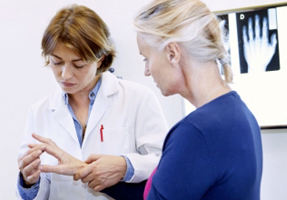Diagnosis of Acquired Valve Disease

Physical exam
During a physical exam, the cardiologist will use a stethoscope to listen to the patient's heart. Sometimes during this procedure a heart murmur can be detected which is indicative of heart valve disease.
A stethoscope is also used to listen to the lungs since heart failure often results in fluid buildup in the lungs.
Doctors will also check to see if the ankles and feet of the patient are swollen due to accumulation of fluids. This can be done by pressing on the patient’s skin with a finger for a few seconds and then releasing the pressure. If the little indentation on the patient’s leg quickly disappears, then there is no reason to worry. However, if the indentation remains for some time, then there is fluid accumulation.
Tests and procedures
 Echocardiography – is a procedure that uses sound waves to view the heart. It can be used not only to check the shape and size of the heart, but also to see how well the heart valves are working. Doppler ultrasound can also evaluate the blood flow through the heart valves and chambers, possibly detecting regurgitation and stenosis. Echocardiography is usually used after electrocardiography to confirm the diagnosis of heart valve disease. The doctor may also recommend performing transesophageal echocardiography in order to get a better image. During this procedure the transducer is attached to a tube which is passed into the patient’s esophagus until it reaches the stomach. Once in place, the doctor can get a clear picture of the patient’s heart.
Echocardiography – is a procedure that uses sound waves to view the heart. It can be used not only to check the shape and size of the heart, but also to see how well the heart valves are working. Doppler ultrasound can also evaluate the blood flow through the heart valves and chambers, possibly detecting regurgitation and stenosis. Echocardiography is usually used after electrocardiography to confirm the diagnosis of heart valve disease. The doctor may also recommend performing transesophageal echocardiography in order to get a better image. During this procedure the transducer is attached to a tube which is passed into the patient’s esophagus until it reaches the stomach. Once in place, the doctor can get a clear picture of the patient’s heart.- Electrocardiography– this method is used to record theelectrical activity of the heart. It can detect signs of a previous heart attack and arrhythmias. It can also show if the chambers of the heart are enlarged.
- Chest X-ray – this method is primarily used to see of the heart is enlarged. It can also show if there is an accumulation of fluid in the lungs. An X-ray can also detect if the heart valves are covered by calcium (due to old age).
- Cardiac catheterization - During this procedure, a catheter (a long thin tube) is inserted into a blood vessel in the upper thigh, arm, or neck, and guided using MRI until it reaches the heart. An X-ray positive solution is then injected into the heart to obtain a good scan of the heart. Moreover, the end of the catheter can contain a tiny pressure sensor enabling the doctor to measure the blood pressure in different parts of the heart. This procedure is usually recommended if the results provided by echocardiography do not match the symptoms that the patient is experiencing.
- Stress test - This test measures how well the heart can respond to external stress. Stress can be induced through exercise (using a treadmill or a stationary exercise bicycle) or drug stimulation (this method is used for patients who are unable to exercise). During the test, the patient is connected to an electrocardiogram. Echocardiography and myocardial perfusion imaging using radiotracer are also used to assess the state of the coronary arteries before and after the exercise.
- Cardiac MRI - This technique uses radio waves and a powerful magnet to create detailed images of the heart. This method can confirm the diagnosis of heart valve disease and provide more detailed information. MRI is also performed before a surgery.
Next Chapter: Treatment of acquired valve disease









